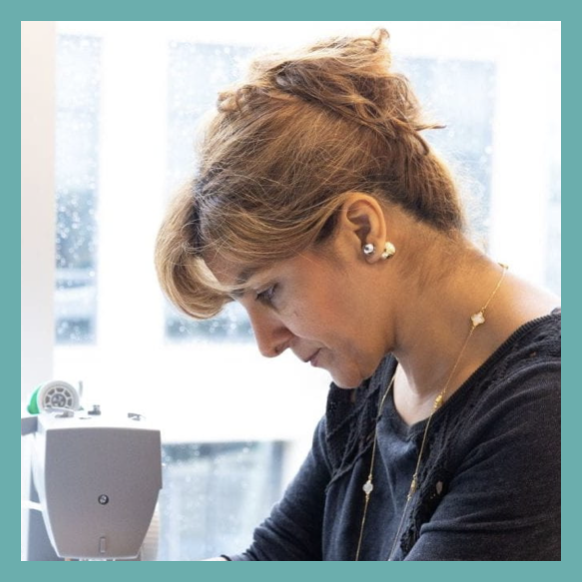Marjan Ashrafi, designer, and Dr. Martha Hall collaborator, recently did something that no one else has ever been able to achieve, as far as we know: She knitted Kevlar™
Working as part of the team at the University of Delaware Innovation Health & Design Lab, Marjan Ashrafi recently accomplished something no one else on Earth has ever been able to do: She knitted Kevlar™, the patented, super-tough textile invented by DuPont.
Before we get into why that matters, it’s helpful to know how Kevlar is made today. It starts out as a lump of malleable plastic, which is then forced through a screen to produce individual strands.
(If you ever used a Play-Doh Fun Factory extruder to make “spaghetti,” it’s like that but at an industrial scale.)
The strands are then woven into a fabric that’s five times stronger than steel of the same weight. It resists cuts, tears, heat, and projectiles and is used in applications from consumer motorcycle jackets to satellites and spacecraft like the Mars Pathfinder.
OK, Knitted Kevlar. What’s the Big Deal?
Here’s the keyword in that description above: woven. Anyone who works with textiles already knows what most everyone else does not:
- Woven materials are produced by layering multiple strands over and under one another to make big, flat pieces that need to be cut and sewn or glued together to create the shape of a garment.
- In contrast, knitting allows you to engineer form and fit directly into a garment as you turn a single long strand of fiber into shaped, often elastic fabric by looping and inter-looping that strand in a series of parallel tracks.
While the difference may seem unimportant for the clothes we wear every day, it has huge ramifications for something like a bullet-proof vest. In mission-critical protective gear, fit, flexibility and minimal seams (which create weak points) can mean the difference between life and death.
So, the fact that Marjan – after months of experimentation and refinement, of complex programming and reprogramming the lab’s $200K Shima Seiki knitting machine (and so many broken needles!) – was finally able to do what even the U.S. military could not, well… that’s kind of a big deal.

Psychologist, Designer, Trailblazer
Knitting Kevlar is an achievement perhaps unsurprising from someone who is no stranger to reinvention. More than 20 years ago, Marjan emigrated to the United States from her home country Iran, where she’d built a successful career as a counselor.
Since her degree wouldn’t have allowed her to practice counseling in the US, Marjan decided to pursue something else that had always been a private dream. In 2015, she added a Bachelor of Science in fashion design from the University of Delaware to her degree in psychology.
Today, Marjan applies both knowledge sets to her work at the Innovation Health & Design Lab, as well as to Coral, her own line of custom, handmade apparel, which she established in Iran in 2017.
With a focus on dresses for special occasions as well as everyday evening wear, Marjan sees parallels between her work with Dr. Martha Hall and her own design business:
- Novelty – Marjan loves things new and unconventional; one of her greatest inspirations is legendary fashion icon Dame Vivienne Westwood, who first came to fame in the 1970s by mainstreaming edgy looks from punk street fashion
- Empathy – For Marjan, both begin with analyzing and working to understand someone: their body as well as who they are and what they want. “Design is all about the individual,” she says. “Each person is different, and the work of fashion is to highlight the positive.”
A Bridge Between Worlds
While Marjan forges new ground in technology that could transform how Kevlar is made and used, she’s also working with Dr. Martha Hall and students on a number of design prototypes.
Today, most of that work centers on innovations for which knitting creates functional advantages. She’s become the lab’s unofficial “Shima Seiki whisperer,” helping others learn a sophisticated and often finicky machine that can require eight or nine hours of programming to execute a single chain of knit.
At the same time, she continues to build her own business of custom designs in Iran, which may soon expand to include luxury couture. “Working with Martha actually helps me to design for my own line,” she notes, “and working on my own line helps my work with Martha.”
Both are, after all, built on the fundamental belief that what we wear has the potential to make life better, whether that’s a knitted compression sleeve to manage chronic illness or a gown that makes a woman feel confident and beautiful on the night of her granddaughter’s wedding. “I love working on these kinds of goals,” Marjan says with a wide smile. “And I feel that both are somehow connected.”

